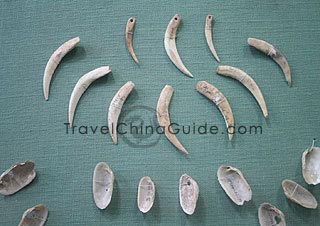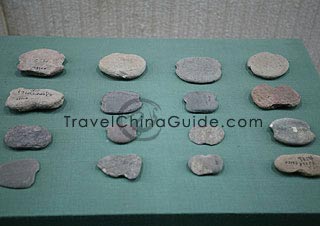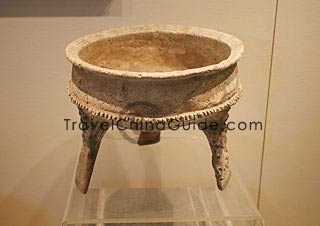Longshan Culture
 |
| Decorations Exhibited in Xi'an Banpo Museum |
Examples of Longshan Culture that were produced in the late period of the Neolithic Age (2900 BC to 2100 BC) can be found in the old town of Longshan, in the city of Zhangqiu which is located in Shangdong Province. Its influence can be found in the middle and lower areas of the Yellow River Valley flowing thru Shandong, Henan, Shaanxi, and Shanxi Provinces. Artifacts from the Longshan are characterized with the applications of both copper and stone.
Compared with the Yangshao Culture, farming techniques in agriculture and the raising of livestock have greatly improved in the Longshan Culture. Farmers from the Longshan Culture planted millet as the main crop, and raised pigs, dogs, sheep and cattle. They also made great advancements in the area of tool making, and were able to create many tools made of stone that would include stone knives used to drill holes, as well as stone reaping hooks, and stone shovels to name just a few of their more common tools.
 |
| Rudimentary Chipped Stone Tools |
The Longshan Culture also made great advancements in the area of pottery making, with black pottery being one of the more striking examples of this remarkable culture. Pottery was made using techniques that enabled the artisans of the Langshan Culture to produce large numbers of pieces while at the same time maintaining a sense of quality. Some of the walls of the pottery were as thin as eggshells with surfaces that were quite bright. Some of the more common pieces produced were bowls, basins, jars, urns and a variety of cooking vessels. Nowadays, the black pottery that was and continues to be produced have been regarded as works of art, and are appreciated and sought after by many people.
In architecture, the rectangular earth-platform pattern buildings were set up during that time which can be seen in the remains of the Longshan Culture found in Shangdong Province. The earth platforms were constructed by a technique known as 'rammed earth' that came into being during the Shang Dynasty (16th B.C-11th B.C.). In recent years, at least ten of these kinds of platforms have been found with seven of them closely situated in a group in Shandong Province.
 |
| Three-legged Jar |
The Longshan Culture also had some rather interesting customs when it came to burying their dead family members in a cemetery that was usually separated from the area where they actually lived. It was common for one person to be buried in a rectangle pit, while occasionally a few would be buried together in a single pit. Children, as those of the Bampo Culture period would be put into urns before being buried. Bones used for predicting one's fortune, and made from the bones of sheep, pigs, deer and cow have been found in the graves from that period. With this in mind it is believed that the custom of augury or divination may have been popular and practiced.
With the development of social productivity, women's dominate place in the Longshan Culture began to give way to men as they began to play more important roles in farming and the developing handicrafts industry. Family life based on the principle of monogamy was established, and at the same time polarization between the rich and poor also began to gradually appear. With the advancements being made in so many areas of the society, the Longshan Culture like so many other cultures was subjected to changes that needed to be made in order to continue its remarkable development.